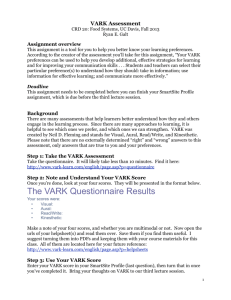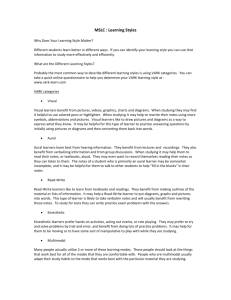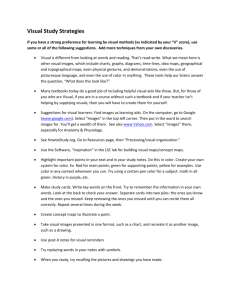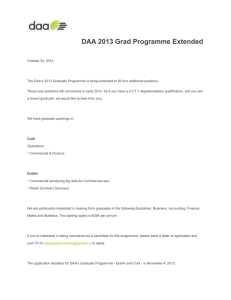Survival of students with different learning preferences
advertisement
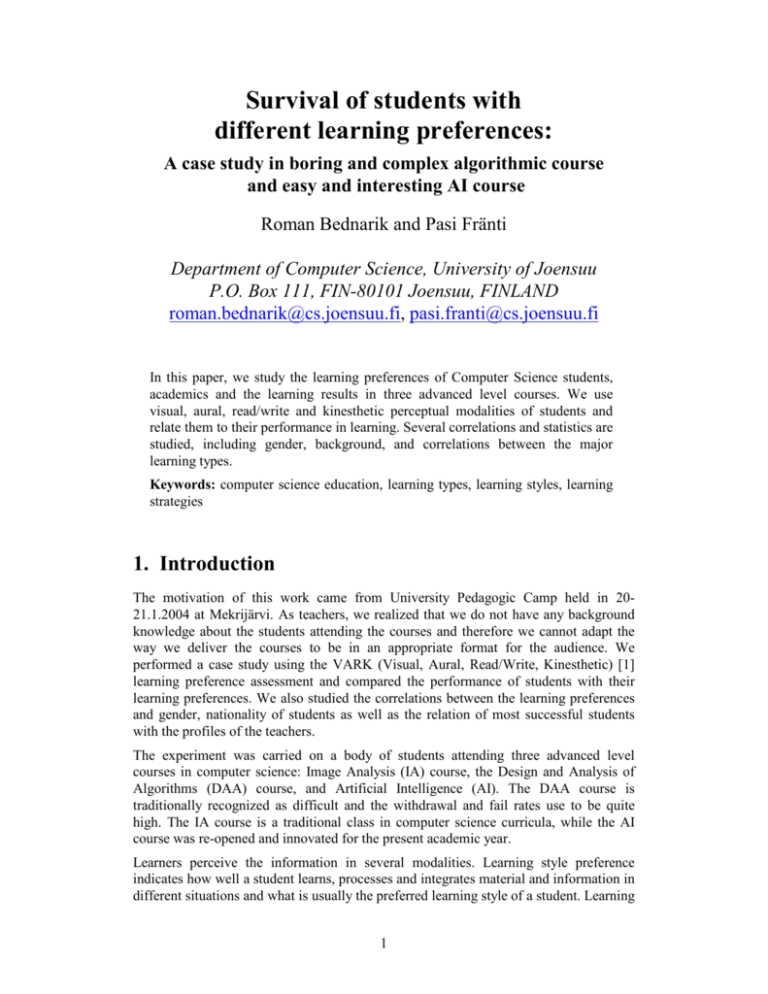
Survival of students with different learning preferences: A case study in boring and complex algorithmic course and easy and interesting AI course Roman Bednarik and Pasi Fränti Department of Computer Science, University of Joensuu P.O. Box 111, FIN-80101 Joensuu, FINLAND roman.bednarik@cs.joensuu.fi, pasi.franti@cs.joensuu.fi In this paper, we study the learning preferences of Computer Science students, academics and the learning results in three advanced level courses. We use visual, aural, read/write and kinesthetic perceptual modalities of students and relate them to their performance in learning. Several correlations and statistics are studied, including gender, background, and correlations between the major learning types. Keywords: computer science education, learning types, learning styles, learning strategies 1. Introduction The motivation of this work came from University Pedagogic Camp held in 2021.1.2004 at Mekrijärvi. As teachers, we realized that we do not have any background knowledge about the students attending the courses and therefore we cannot adapt the way we deliver the courses to be in an appropriate format for the audience. We performed a case study using the VARK (Visual, Aural, Read/Write, Kinesthetic) [1] learning preference assessment and compared the performance of students with their learning preferences. We also studied the correlations between the learning preferences and gender, nationality of students as well as the relation of most successful students with the profiles of the teachers. The experiment was carried on a body of students attending three advanced level courses in computer science: Image Analysis (IA) course, the Design and Analysis of Algorithms (DAA) course, and Artificial Intelligence (AI). The DAA course is traditionally recognized as difficult and the withdrawal and fail rates use to be quite high. The IA course is a traditional class in computer science curricula, while the AI course was re-opened and innovated for the present academic year. Learners perceive the information in several modalities. Learning style preference indicates how well a student learns, processes and integrates material and information in different situations and what is usually the preferred learning style of a student. Learning 1 preference may change over the time. With an increasing experience some preference can be masked or suppressed over some other. Learning preference assessment relates also to the concept of multiple intelligences. 2. Learning preferences Several divisions and assessments of learning preferences exist. For the present research, we used the VARK method and questionnaire [1]. The acronym VARK comes from the following four modalities that are assessed from the results of the filled questionnaire. Visual (sight) Aural (hearing) Read/Write Kinesthetic A learner showing a priority in the Visual modality prefers learning using charts, symbolic representations, or video materials, over the auditory input as e.g. instructor’s explanations or verbal presentations. The Aural/auditory perceptual preference often indicates that a learner perceives best the information which is auditory, verbal and therefore heard. Aural students prefer discussions, chats, explanations in words or lectures. The Read/Write modality refers to the fact that the perception of input and production of output is preferred in reading and writing, representing the information in textual format rather than in sound or graphics. According to [1], this learning preference is found the strongest in most of the academics. The Kinesthetic preference emphasizes the hands-on experience over the other perceptual modalities, stressing the importance of real or simulated practice. Learning preference can change over the time, with maturing and gained experience. At the same time, the preferred perceptual modality as measured by the VARK questionnaire cannot be used to create a strong conclusion about the strengths or weaknesses of an individual in learning process. Considering the input and output, it is suggested that a preference of a certain modality for one of them (e.g. for input) is also reflected in preference of the other (for output, in our example). Finally, it has to be kept in mind that a learning modality preference is rather a simplified concept and does not describe a learner wholly. Moreover, the VARK profile does not describe other abilities thought to be foundational for a successful learning. Another methods to estimate the learning preferences have to be used, for instance for the group vs. individual work preference assessment or for intuitive vs. exact information intake preference. It has to be remembered, that a preference in a certain modality does not grant good learning results. 3. Experiments 3.1 Courses and participants The experiment was conducted on three graduate level courses (part of MSc studies in computer science) held in during the academic year 2003-2004, at the Department of Computer science, University of Joensuu, Finland: 2 • • • Design and Analysis of Algorithms (DAA) Artificial Intelligence (AI) Image Analysis (IMA) The VARK questionnaire was first implemented during the DAA course, and therefore, most of the students answering the questionnaire have results for this course. The questionnaire was then administered in the AI course. Later, we decided to include also the Image Analysis course into this study, as many of the students had taken this course, too and data were available at hand. The first author was one of the two teaching assistants in the AI course, and the second author was the lecturer in the DAA and IMA courses. The details of the curses in the study are summarized in Table 1. Table 1: Three courses included in the study. Course DAA AI IMA Period Spring 2004 Spring 2004 Fall 2003 Credits 4 cu 3 cu 3 cu Students 32 12 17 Design and Analysis of Algorithms (DAA) [2] is a four credit-units advanced level course. The topics cover the concepts and principles of algorithms, their implementation, analysis and practical use. The course was delivered in lecturedemonstrations-exams format, scheduled every week with the two two-hour lectures and one two-hour demonstration session. Students pass the course by performing two intermediate exams, visiting demonstrations and completing the assignments. The three credit-units course of Artificial Intelligence (AI) [3] was delivered in an interactive format: about a week before every lecture (scheduled two hours per week, totally 15 weeks), the course leader announced the topic and a relevant literature to students, who studied the subject matter in advance. The lecture time was mainly dedicated for a discussion about the present topics rather than lecturing and delivering information only from the teachers to students. The students kept the learning diary and processed selected topics off-class, delivering both of them weekly to the course tutors. The topics of independent homework were discussed in a weekly held two-hour demonstration session. The AI course project formed about 60% of the final grade. Image Analysis (IMA) course [4] discuss the topics of digital image processing and analysis, such as histogram manipulation, shape and motion detection, image retrieval or image processing. The course is scheduled with two two-hour lectures and one two-hour exercises session per week. The requirements for passing the IMA course were about similar as those of DAA course. The students in all of the courses were Finnish undergraduate and graduate students in computer science, international graduate students mainly from Russia (but also from Romania, India, Czech Republic, and El Salvador), and a few Spanish exchange students. All together there were 42 student profiles analyzed, from which 14 were females and 19 were collected from foreign students. Since it is claimed, that members of academics show a preference in Read/Write modality, we also collected the VARK profiles for the teachers of the courses and some members of authors’ department. 3 3.2 VARK questionnaire The VARK questionnaire1 consists of 13 multiple-answer questions. Questions typically present some everyday situation and provide three or four possible answers related to one of each V, A, R, and K categories. These relations are not disclosed to the tested subject who can mark one or more preferred answers to the problem. Marking an answer gives one point for the particular category. In total, answering all questions and marking all possible preferences can yield to 12 points for each of V, A, R, and K. To enforce some level of validity, a user is required to answer to at least 10 questions. A sample question in the VARK questionnaire is shown below. The bold letters in parentheses indicate the modality an answer is supposed to assess. You are about to give directions to a person who is standing with you. She is staying in a hotel in town and wants to visit your house later. She has a rental car. I would: • draw a map on paper. (V) • tell her the directions. (A) • write down the directions (without a map). (R/W) • collect her from the hotel in a car. (K) For the purposes of the present study, an online version of the VARK questionnaire was used (http://cs.joensuu.fi/~rbednari/vark/). Beside for an easy maintenance and accessibility, it allowed for an automatic collection of the results through email. Apart from the scores of each of the modalities separately, the results also contained the most preferred modality and its strength of a subject, which were computed as a highest score among the four modalities and its distance from the second highest, respectively. During the processing of the results, the scores were normalized in order to allow for a comparison between subjects: the scores of each of the VARK categories were divided by the total number of answers. The highest score for a certain modality suggests the preference in learning in a certain way. However, it does not necessarily show the strength or weakness of a learner but rather an indication. Therefore, the results can be interpreted as a recommendation for a preferred learning style only but not as a complete assessment of a learner. The preferred modality shall indicate is the way of taking and producing the information to achieve a maximum learning effect. Similarly, the results can reveal the possible difficulties if a certain learning strategy is imposed on a student. 3.3 Working hypotheses Our working hypotheses were following: 1. Certain learning types perform better than other types. 2. Students with a similar VARK profile to teachers might perform better. 3. Different teaching methods suites better for a. Good teaching material (books/ notes) -> R might do better. 1 Permission has been obtained for use of these materials. 4 b. Inspiring teacher -> Aural students might do better. c. Problem-based learning -> Might suite better for K. We suggest that the role of teacher and his/her way of delivering a course interplay with the students of certain learning preference. For example, if the teacher her/himself is of a visual type, s/he unconsciously provides the information best in the visual format. Therefore, the students whose learning preference is visual might understand the knowledge presented better than students with other learning preferences. Furthermore, we could hypothesize that the traditional behaviorist approach to lectures advantages Aural students, the self-study can be appreciate by the R/W type of learners, and Kinesthetic students would attain best learning effect during the practical demonstrations of subject matter. 4. Results and Discussion 4.1 VARK profiles of participants Table 1 present the profiles of academics included in the study. The teacher and assistant of the DAA and IMA courses show a strongest preference in the Visual modality. The lecturer of the AI course tends to prefer the aural perception, while the assistant in the AI course shows a balanced preference between Visual and Kinesthetic modalities. Other faculties (except the Human Sciences professor but including assistant of DAA) come from the research group of the teacher of the DAA and IMA courses. It can be observed that two key persons (researcher and project manager) exhibit a similar distribution of the learning preferences as the group leader, while the two project workers show a reference towards kinesthetic modality. In overall, the average profile of the academics in this study showed 26% of Visual, 22% of Aural, 24% of Read/Write, and 29% of Kinesthetic preference. Table 1. VARK profiles of academics Professor (Human Sc.) Professor (Comp. Sc.),DAA,IMA Researcher Researcher Researcher Project manager Project worker Project worker Lecturer AI Assistant DAA, IMA Assistant AI V 4 5 8 4 5 6 4 3 4 6 7 A 2 4 4 5 8 3 2 6 8 1 4 R 10 2 4 4 4 3 5 6 4 4 5 K 7 3 6 3 7 5 7 7 6 5 7 Figure 1 show the profiles of all the students in the study. The average normalized VARK profile computed from the profiles of all the students involved in the study shows a distribution of 23% of V, 21% of A, 24% of R, and 31% of K. The modalities 5 were varying as follows (minimal-maximal %): Visual 6-45%, Aural 0-43%, Read/Write 6-44%, and Kinesthetic 15-50%. It can be observed that there were participants in the study without any Aural preference, while everybody had at least 15% of Kinesthetic preference. There was a participant with very strong 50% preference towards the Kinesthetic modality. From our observation, this student is known to be very active, practical and hard working. Study types in DAA 100 % 90 % 80 % V 70 % 60 % 50 % A 40 % 30 % R 20 % 10 % K 0% Student Figure 1. Normalized VARK profiles for the students in the study. In order to investigate whether there was a relation between the V, A, R, or K variables, we run several correlation computations. Table 2 shows the correlations of the absolute values of all the dimensions V, A, R, K, collected during the study. No significant correlation between VARK variables was observed, which indicates that they are independent on each other. Table 2. Correlation factors of the absolute values of learning types. V A R K V 1.00 0.14 -0.07 0.03 A R K 1.00 0.05 -0.11 1.00 0.27 1.00 4.2 Classification of students’ profiles We investigated the hypothesis, that there might exist four distinct clusters, corresponding with the main four prevailing V, A, R, K modalities. The students are grouped into four clusters according to their VARK profiles in four dimensional Euclidian space, using algorithm as in [5]. Each cluster is constructed so, that the within-cluster similarity is maximized. Each of the dimensions corresponded with the V, A, R, K variables. The division of the population in the study made by the clusters can be observed as vertical lines in Figure 1. Figure 2 shows four groups into which the students were divided. It can be observed that the clustering does not correspond with the VARK modalities i.e., in general, the average profiles of the four groups do not show a strong majority of one modality in cost of lowering the other. Group 1 learning profile is characterized mainly by its low preference in visual modality, but relatively evenness of all others. Group 2 has a 6 learning profile with high visual and very high kinesthetic modalities emphasized. This indicates that the group formed by this type of students would most probably not prefer to perceive and produce the information in Aural and Read/Write modalities. Group 3 has a profile that is characterized by a rather equal presence of all four modalities with a slight preference towards visual perception. In Group 4 profile, the read/write and kinesthetic modalities are emphasized. V Group 1 13 % A R 25 % 28 % Group 2 31 % 11 % 17 % Group 3 30 % 27 % Group 4 18 % 0% 16 % 20 % K 33 % 40 % 20 % 24 % 34 % 40 % 32 % 60 % 80 % 100 % Figure 2. Average profiles of the four clusters. All groups have equal proportion of different nationalities; except for the Group 1 which contains less foreign students than other groups, as seen in Table 3. The explanation behind this result can be that in our study there were only few foreign students which were distributed randomly across the clusters. 4.3 Analysis of performance of clustered groups The performance of the students classified into the most separable four clusters is shown in Table 3. Due to the different grading criteria in the courses, the scores are normalized on a scale from 0 to 100% of the maximal grade or points. After this transformation, a student with less than 48 percent of a maximal grade would not pass a course. Considering the performance of students and their relative groups, students in Group 1 and 3 have performed best in IMA course, and Group 3 students best in DAA course, and students of Group 4 performed best in AI course. Table 3. Statistics and scores’ percentages of the students in the four groups. Group 1 Group 2 Group 3 Group 4 Finnish students 80 % 50 % 46 % 50 % 7 DAA AI IMA 47 50 70 50 54 <48 65 76 90 63 97 70 When the distributions of the modalities of the most successful groups are compared, it can be observed that Aural types (modality of Groups 1 and 3 in common) performed well in IMA, Aural and Visual types (Group 3) performed best in DAA, and Read/Write students (Group 4) did well in AI course. In overall, a hypothetical student with the learning profile matching the Group 3 average profile would perform best in all the courses, while the student taken from the Group 2, would most probably experienced several problem with passing the courses in this study. It can be suggested that a student with a balanced profile, as seen in Group 3, survives best, since all the modalities are present and provide the student capability to perceive and output the information in all four modes. 4.2 Comparison of VARK modalities with the course results To complement the results presented in the previous sections, we analyzed the relations between the V, A, R, and K scores and the results of the whole population of students involved in the study. Table 4 presents the correlations of the VARK scores with the results of the courses for all the students in the study. Considering the DAA course results, there was no significant correlation with either V, A, R, or K scores, although the K variable was slightly negatively correlated with the results in the DAA. Interestingly, there were some correlations found when the VARK scores and results in AI course were compared. The Read/Write attribute was positively correlated and the K score was negatively correlated with the results in AI. This suggest that the learners with higher preference in Read/Write modality got, in general, higher grades, while the learners preferring the Kinesthetic modality got lower grades. In the IMA course, we observed a positive correlation between the Aural scores and the results and a negative correlation of the Kinesthetic scores. All the mentioned correlations were of about the same magnitude. Table 4. Correlations of the VARK scores and the courses’ results. V A R K DAA 0.15 0.12 0.01 -0.33 AI -0.18 0.14 0.47 -0.57 IMA 0.05 0.47 -0.16 -0.44 It can be suggested, that a student who is a good learner and perform well in some course, perform also well in another course. This is supported by results in the Table 5 which shows a view on the correlations between the final results of the three courses in this study computed for all the participants. The exception seems to be a relatively lower correlation between the results of the IMA and AI courses. Table 5. Correlations of the students’ results. DAA AI IMA DAA 1.00 0.48 0.42 8 AI IMA 1.00 0.19 1.00 Finally, we divided the students into four categories, V, A, R, and K, according to their strongest learning preference and compared the average performance of this way formed four groups in the courses in this study. The results are shown in Figure 3. Average performance for each learning type 100% Visual Aural R/W Kinesthetic 90% 80% 70% 60% 50% 40% 30% 20% 10% 0% DAA AI IM A Figure 3. The mean perfomance of each learning type in the courses. Not surprisingly, all the students did not perform the same in some course. However, we can notice an observable difference while considering a certain learner and her/his performance in all the courses. For instance, the learners whose strongest modality was V, performed best in DAA and second best (with an excellent grade) in the IMA course. When taking the AI course, the same students, in general, did not pass. Somehow an inverse phenomenon concerns the learners whose strongest modality was Kinesthetic: they would (although hardly) pass the DAA course and perform well in the IMA course, but they would not pass the AI course. The students of Aural and Read/Write preference would perform on or above the average. 5. Conclusions In this study, we have collected the learning profiles of students and several academics. We compared the performance of students based on several classifications in three advanced-level courses in computer science. We classified students according to several criteria and analyzed the learning preferences of such formed clusters and their respective results. Our first hypothesis does not seem to be valid, as supported by the results. There is no best modality in general. The balanced VARK profile seems to indicate a better performance in all three courses in this study. Correlation analysis of VARK parameters and exam results verifies the previous observation: Aural students perform better in Image Analysis course. Slight correlation between DAA and IMA result was observed: doing well in one course indicates that a learner might perform well in another. The claim of the second hypothesis seems to be supported by our results. The profiles of most successful students in a course match the profile of the teacher of the course. Directly, the third hypothesis is supported by the previous one. The teachers used 9 different learning style and the courses were taught differently and these facts were reflected in the performance of students attending the different courses. In our study, faculty and students have the strongest preference in Kinesthetic modality. This result is rather surprising, as it is suggest the academics shall exhibit highest preference in Read/Write modality. For both groups the proportions of V and A preferences are relatively similar. References [1] Neil D Fleming, Teaching and Learning Styles: VARK Strategies, Honolulu Community College, 2001. http://www.vark-learn.com/english/index.asp. (16.5.2004) [2] Fränti, P.: Design and Analysis of Algorithms homepage: http://www.cs.joensuu.fi/pages/franti/asa/ (14.6.2004) LaRussa, G.: Artificial Intelligence homepage: http://cs.joensuu.fi/pages/gaetano/artificial_intelligence.html (14.6.2004) Fränti, P.: Image Analysis course homepage: http://www.cs.joensuu.fi/pages/franti/image/ (14.6.2004) P. Fränti and J. Kivijärvi, "Randomized local search algorithm for the clustering problem", Pattern Analysis and Applications, 3 (4), 358-369, 2000. [3] [4] [5] 10
